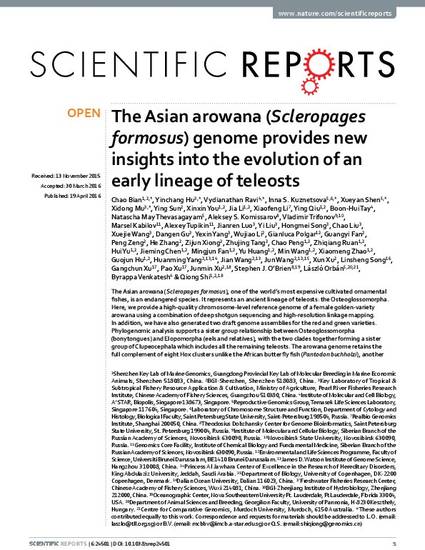
The Asian arowana (Scleropages formosus), one of the world’s most expensive cultivated ornamental fishes, is an endangered species. It represents an ancient lineage of teleosts: the Osteoglossomorpha. Here, we provide a high-quality chromosome-level reference genome of a female golden-variety arowana using a combination of deep shotgun sequencing and high-resolution linkage mapping. In addition, we have also generated two draft genome assemblies for the red and green varieties. Phylogenomic analysis supports a sister group relationship between Osteoglossomorpha (bonytongues) and Elopomorpha (eels and relatives), with the two clades together forming a sister group of Clupeocephala which includes all the remaining teleosts. The arowana genome retains the full complement of eight Hox clusters unlike the African butterfly fish (Pantodon buchholzi), another bonytongue fish, which possess only five Hox clusters. Differential gene expression among three varieties provides insights into the genetic basis of colour variation. A potential heterogametic sex chromosome is identified in the female arowana karyotype, suggesting that the sex is determined by a ZW/ZZ sex chromosomal system. The high-quality reference genome of the golden arowana and the draft assemblies of the red and green varieties are valuable resources for understanding the biology, adaptation and behaviour of Asian arowanas.
Available at: http://works.bepress.com/stephen-obrien/692/

This work is licensed under a Creative Commons Attribution 4.0 International License. The images or other third party material in this article are included in the article’s Creative Commons license, unless indicated otherwise in the credit line; if the material is not included under the Creative Commons license, users will need to obtain permission from the license holder to reproduce the material. To view a copy of this license, visit http://creativecommons.org/licenses/by/4.0/